|
Winged Target - Mark 1 Manual
Rudolf Wurlitzer Company During World War Two
DeKalb Division
DeKalb, IL
1919-1973
Rudolf Wurlitzer Company
1856-1986
This page added 8-3-2023.
The Rudolf Wurlitzer Company is best known for
its manufacture of musical instruments. Previous to World War Two,
the DeKalb Division in DeKalb, IL produced pianos. However, during
World War Two, the Wurlitzer DeKalb Division produced wooden air frames
for two of the U.S. Navy's most secret drone and guided bomb projects.
These aircraft were cutting edge technology for the era and would be labeled high-tech in the current vernacular.
The company also produced tubular steel air targets for the U.S. Navy.
While the U.S. Navy picked the Wurlitzer DeKalb Division for its wood
working ability for the drone and guided bomb project, the manufacture
of the steel air frames was not within its pre-war technology base.
The company had to develop new manufacturing methods within the division
to make this product.
The DeKalb Division of the Rudolf Wurlitzer
Company has not been recognized for the work it did on secret and
cutting edge military weapons during World War Two. This page will
show how the company helped to introduce new aviation technology during World War Two.

This TDR drone is on display at the National
Naval Aviation Museum in Pensacola, FL. While the Interstate
Aircraft and Engineering Corporation of El Segundo, CA was the prime contractor for the TDR series of drones, the Wurlitzer DeKalb Division manufactured all of
the wooden airframe components. This weapon was guided to its
target by a television camera located in the nose. Author's
photo.

This is ASM-N-2 Bat is on display at
the Udvar-Hazy Center of the National Air and Space Museum. All of
the gray airframe on this weapon was built by Wurlitzer DeKalb.
The Bat had its own radar and was able to paint the target and then
direct itself to the target. All of the electronics and guidance
systems were enclosed in the Wurlitzer-built steel and wooden air frame.
This was the world's first operational smart bomb. Author's photo.
Not only did Wurlitzer
DeKalb produce the wooden air frames for the first Navy drones and smart bombs,
but examples of them are in two of the premier aviation museums in the
United States.

The third product Wurlitzer DeKalb designed
and manufactured was this steel tow target. While the previous two
products air frames were mostly wood, this had a steel frame and was
covered with plywood. Also, for the previous two products,
Wurlitzer DeKalb was given engineering drawings by the prime contractors
from which to make the air frames. In this case, a piano
manufacturer designed a small steel aircraft. This is confirmed by
the fact that Wurlitzer DeKalb Division is recognized as the designer
and supplier in the U.S. Navy's manual for the Mark I Aerial Target.
Photo courtesy of the DeKalb County History Center.
Pianos don't fly and are made largely out of wood.
The World War Two products of the Wurlitzer DeKalb Division demonstrate
that during World War Two American companies made and developed products
totally outside of their pre-war product expertise. Product and
manufacturing engineers rolled up their sleeves, pulled out their
slide rules, and designed and built what was required to help win World
War Two.

The hard work at the Rudolf Wurlitzer Company, DeKalb
Division resulted in it winning the Army-Navy "E" Award three times during World War Two.
It won the first award on May 18, 1944, the second award on January 18,
1945, and its last award on September 8, 1945.
Company History: In 1856, Rudolf
Wurlitzer began selling musical instruments in Cincinnati, OH. Until 1908, the company was
exclusively a retail operation with one store in
Cincinnati. In 1908, the Rudolf Wurlitzer Company purchased a
musical instrument manufacturing company in North Tonawanda, NY.
With this and several other musical company purchases, Wurlitzer became
a well known manufacturer of a variety of musical instruments.
In 1919, Wurlitzer purchased the
Melville-Clark Piano Company of DeKalb, IL. This plant continued
to make pianos under several different brand names for Wurlitzer until the beginning
of World War Two, when it switched to war production as documented on
this webpage. After World War Two, the DeKalb plant once again
manufactured pianos until 1973, when it ceased production of the product
line. In 1977, the company's headquarters and engineering staff
from North Tonawanda moved to the DeKalb facility. It was here that the
Rudolf Wurlitzer Company made its last stand before being sold to the
Baldwin Piano Company in 1986.
Luckily, all of the corporate records were
saved and are now part of the historical collection of the Northern
Illinois University in DeKalb, IL.
Rudolf Wurlitzer Company World War Two
Products:
Table 1 -
Rudolf Wurlitzer
Company's Major World War Two Contracts
The information below
comes from the "Alphabetical Listing of Major War Supply
Contracts, June 1940 through September 1945." This was
published by the Civilian Production Administration, Industrial
Statistics Division. |
|
Product - Customer |
Contract Number |
Contract Amount |
Contract Awarded
Date |
Completion
Date |
| Pianos - Army
Quartermaster Corps |
950-QM-04160 |
$63,000 |
6-1942 |
11-1942 |
| Winged Targets -
Navy |
OA-3943 |
$779,000 |
6-1944 |
11-1944 |
| Winged Targets -
Navy |
OA-5322 |
$55,000 |
1-1945 |
5-1945 |
| Winged Targets Mk
2 - Navy |
OA-6200 |
$52,000 |
3-1945 |
4-1945 |
| Air Stabilizers -
Navy Ordnance |
ORD-8520 |
$3,397,000 |
3-1945 |
5-1946 |
| Total |
|
$4,346,000 |
|
|
Army Quartermaster Corps Contract 950-QM-04160
was for $63,000 worth of pianos. Wurlitzer DeKalb Division's first
contract was for its peacetime product. In 1942 a bottom line
spinet piano in the civilian market cost $225. If we assume the
Quartermaster Corps purchased basic spinets for its on-base service
centers and clubs at $225 each, then it purchased 280 pianos. If
the Army paid less because of the quantity purchase, such as $200 per
piano, then 315 were obtained. Every military unit seemed to have
several piano players in it who would entertain others with their talent. Pianos were
staples of service centers, USOs, officers' clubs, and enlisted men's
clubs.
Next, the Wurlitzer DeKalb Division began
producing wooden aircraft components for the war effort. The size
of these contracts were either smaller than the $50,000 minimum required
to appear
on the major contract list, or the division was contracting directly
with the aircraft manufacturers.
On September 26, 1942, it was announced in the
DeKalb Daily Chronicle headlines that "NAVY AIRPLANES ARE TO BE BUILT IN
DEKALB." This was a really big deal for the DeKalb area as it did
not previously have much war work. Building aircraft for the U.S.
Navy, which were important weapons in the war, was an exciting product
for the area. The article noted that DeKalb was picked because of
the Wurlitzer DeKalb Division's expertise in manufacturing wood
products.
Navy winged targets contracts OA-3943, OA-5322,
and OA-6200 totaled $886,000, which was 20% of the division's total World
War Two contracts. The Navy's $3,397,000 contract ORD-8520 for Air
Stabilizers was 78% of the division's contracts. The description
of Air Stabilizers appears to have been the contract for the ASM-N-2 Bat
air frames and was used to disguise the actual top secret nature of the
product.
Interstate Aircraft and Engineering
Corporation was awarded a $14,525,000 Navy contract to build TDR drones
in DeKalb, IL. A percentage of this amount was used to purchase
the molded wood air frame components from the Wurlitzer DeKalb Division.
TDR Drones:

This and the next five photos are of the TDR
drone that is on display at the National Naval Aviation Museum in
Pensacola, FL. The photos give different views and perspectives of
this aircraft. It is the only known example left of the 195 built.
This should not be surprising because firstly, they were flown directly
into the target and destroyed; and secondly, being made of wood, they
were subject to rot and insect destruction. Author's photo.
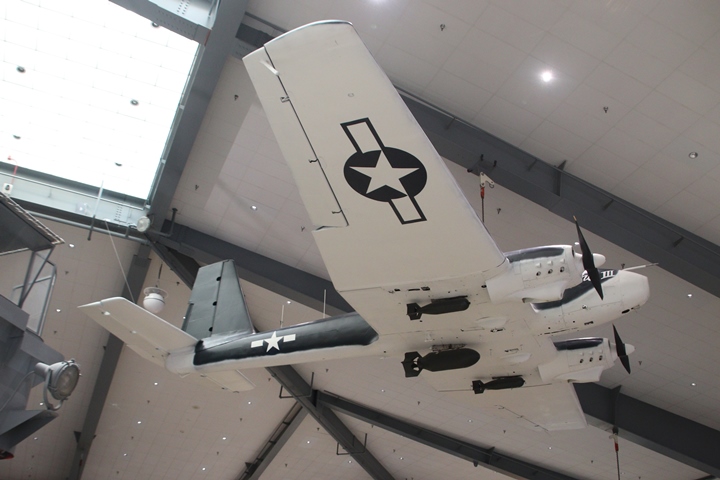
Author's photo.

Author's photo.

Author's photo.

Author's photo.

In the nose of the aircraft is the location
of a television camera. The signal from the camera was transmitted
to another aircraft where the drone operator monitored the drone's
signals on a television receiver. The drone operator then used a
joy stick to guide the drone to the target. Author's photo.

The Early Television Museum in Hilliard, OH
has some of the RCA television equipment used in the TDR drone. On the
left is the television camera that was located in the nose of the TDR;
and on the right is the receiver the operator looked at in the control
aircraft to direct the drone. Author's photo.

Author's photo.
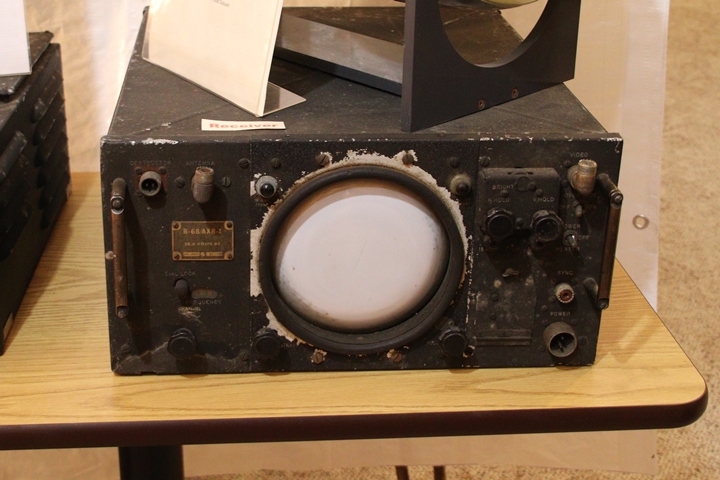
Author's photo.
The Roger Keys Collection: Mr.
Keys has spent many years researching and collecting information on the
production of the TDR drone in DeKalb, IL. He is the subject
matter expert on TDR drone production. The following photos were
taken at the 2023 TBM Reunion in Peru, IL. Mr. Keys had both an
inside and outside display on the TDR at the event.

This and the next six photos are of Mr.
Keys' outside display. These are Wurlitzer-built components that
Mr. Keys rescued from the company's former factory. This and the
next three photos are examples of the wing spars. Author's photo.

Author's photo.

Author's photo.

Author's photo.

Mr. Keys was able to rescue this rear
fuselage section of the TDR from the former Wurlitzer plant.
Author's photo.

This pilot canopy is also part of Mr. Keys'
collection. The TDR could either be flown by a pilot or remotely
controlled from another aircraft. Once the aircraft was assembled
in the Interstate factory in DeKalb, U.S. Navy pilots then did test
flights in them to assure they were properly assembled. The TDRs
had a limited range. In the vast Pacific where they operated, a
pilot would fly the aircraft to a location near the final target.
There, navy technicians removed the canopy and replaced it with a
conformal fairing. Author's photo.

Author's photo.

This image shows Mr. Keys' display inside
one of the hangars during the TBM reunion. Author's photo.

This model of the TDR drone set Mr.
Keys on his lifetime research of the aircraft. He found this many
years ago at a rummage sale and purchased it. However, he did not
know what it was and for many years attempted to find out what type of
aircraft this was. Finally, he met a person that explained its
significance and that it was built in DeKalb, IL. He then began
his research project on the TDR and the collection of the parts from the
Wurlitzer factory. Author's photo.

Mr. Keys was able to rescue two cockpit
canopy assemblies. This one is on display at the DeKalb County
History Center. Author's photo.
ASM-N-2 Bat: Wurlitzer
performance in building air frames for the TDR drone must have impressed
the U.S. Navy. Once the TDR contract was terminated, the company
was awarded U.S. Navy contract ORD-8520 for $3,397,000 to build the air
frames for the ASM-N-2 Bat. One source shows that Wurlitzer built
2,580 air frames for the Bat, making it the company's largest production
run of World War Two. However, it appears that production only ran
between March 1945 and September 1945. The 2,580 figure may well
be overstated. The important fact to remember is that a piano
maker made the airframes for this World War Two high-tech secret weapon.

This Wurlitzer-built ASM-N-2 Bat is on display at
the Udvar-Hazy Center of the National Air and Space Museum.
Author's photo.

Author's photo.

This and the next two images show a finished
Bat and the inventory of parts in the former Interstate plant.
Once the TDR project ended, the U.S. Navy gave possession of the former
Interstate final assembly plant to Wurlitzer to build the ASM-N-2.
Photo courtesy of the DeKalb County History Center.

Photo courtesy of the DeKalb County History
Center.

Photo courtesy of the DeKalb County History
Center.

This and the next image show ASM-N-2 outside
the factory. Photo courtesy of the DeKalb County History Center.

Photo courtesy of the DeKalb County History
Center.

This image shows the ASM-N-2 Bat on the wing
of a PB4Y-2.
Winged Targets:
This is the most interesting and, at the same time, the most unknown
of the DeKalb Division of Wurlitzer's World War Two products. It
is interesting in that it was a metal frame winged target covered with
either plywood or fabric, depending on the model. Steel
fabricating was not Wurlitzer's forte, so it may have performed the
design work and had the steel frame welded at an outside supplier.
The Mark 1 winged targets are virtually unknown to current historians.
It was only because the DeKalb County History Center has photos in its
collection that I was able to discover that Wurlitzer manufactured them
for the U.S. Navy during World War Two.
It is unknown how many were produced and if
any of them were actually used as tow targets. The normal World
War Two target was a fabric sleeve that was pulled behind an aircraft.
Only the photos shown below from the DeKalb County History Center and
manual AN-28-10A-1 survive.

Photo courtesy of the DeKalb County History
Center.

Photo courtesy of the DeKalb County History
Center.

The wing span of the winged target was 13
feet, 4 inches. Photo courtesy of the DeKalb County History
Center.
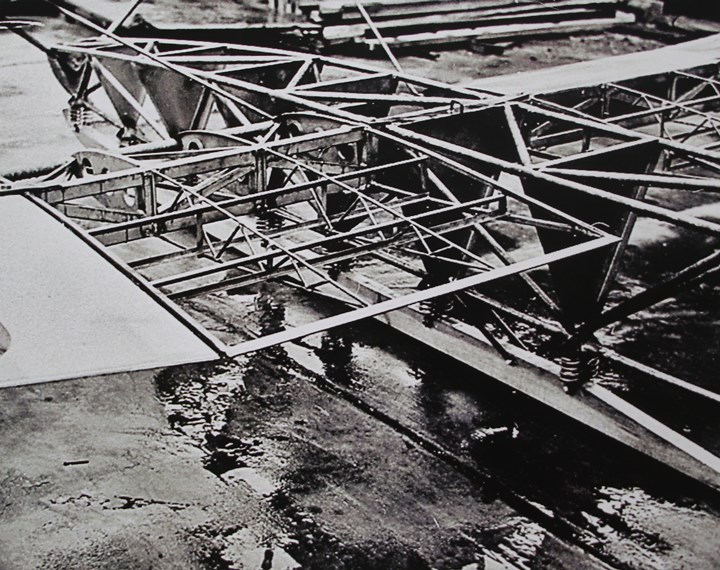
The Schwinn Bicycle Company of Chicago, IL
was subcontracted for the welding of the steel frame components on the
TDR project. Schwinn may well have also been contracted to do all
of the welding for Wurlitzer on the winged target. The welded
components shown here are very similar to those on a bicycle.
Photo courtesy of the DeKalb County History Center.

While the printed date on this manual is May
1, 1946, the original date was issued was December 1, 1944. This
would imply that the wing targets were used for the duration of the war.


Section 1 notes that this product was
manufactured by the DeKalb Division of the Rudolph Wurlitzer Company.
Section II gives an excellent description of the winged target.
Paragraph a. indicates that this is based from an RAF design of a
similar winged target.


Army-Navy "E" Award: Below is the
pamphlet each employee received for the presentation of the first "E" on
June 22, 1944.

Photo courtesy of the DeKalb County History
Center.
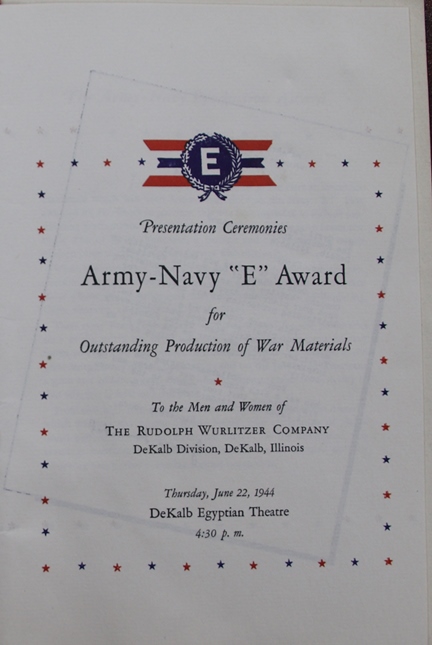
Photo courtesy of the DeKalb County History
Center.
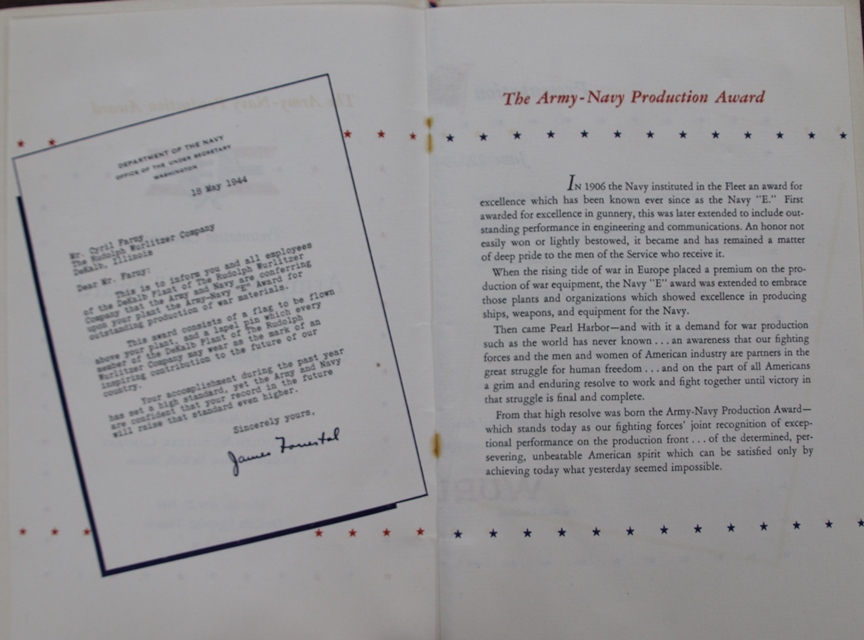
Photo courtesy of the DeKalb County History
Center.

Photo courtesy of the DeKalb County History
Center.

Photo courtesy of the DeKalb County History
Center.

Photo courtesy of the DeKalb County History
Center.
The Wurlitzer Plants: During
World War Two, Wurlitzer operated out of two factories. The first
was its normal manufacturing plant between Pleasant and State Streets in
DeKalb. In March 1945 it took over the plant previously used by
Interstate to assemble the TDR. In this plant, Wurlitzer produced
the ASM-N-2 Bat.
The only remaining portion of the Wurlitzer
plant is now occupied by the "Classic Auto Factory." The long
north-south building at the intersection of Pleasant Street and North
Peace Road is the plant used by Interstate to assemble TDR drones and
Wurlitzer to assembly the ASM-N-2 Bat. This plant was originally
built to be the world's longest factory for the manufacture of
furniture. After the war, General Electric purchased the plant.

Image courtesy of Google Maps.
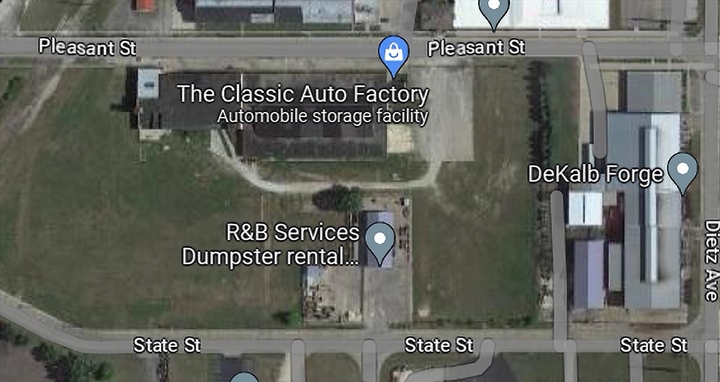
Image courtesy of Google Maps.

This early 20th century postcard photo shows
the DeKalb Wurlitzer complex when it was still Apollo Piano Company.
Apollo was one of the several trade names Wurlitzer used to market
pianos.

This is another early view of the factory.

I was at the location of the former
Wurlitzer factory complex in May 2023. There is only one two story
building still standing. This photo is looking to the northeast
from State Street and the railroad tracks. I tried to capture the
emptiness of the area. All of the grassy area at one time was
occupied by factory buildings. Author's photo.

Author's photo.

This image is looking east with Pleasant
Street on the left. Author's photo.

Author's photo.

Author's photo.

This image with Pleasant Street in the
foreground is looking west. Author's photo.
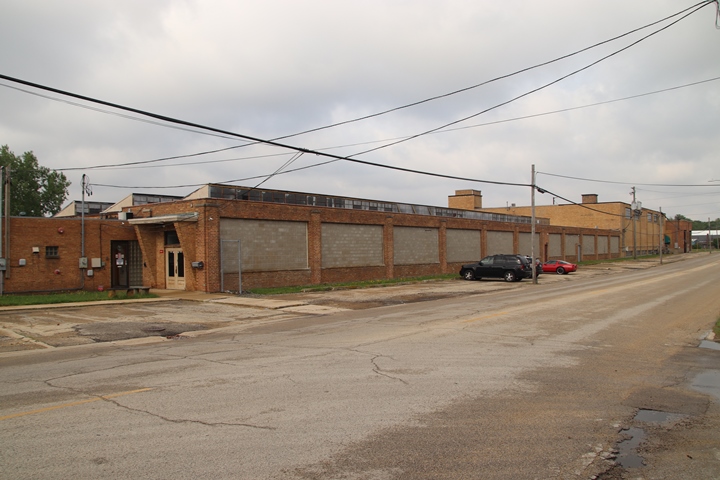
Author's photo.

There is not much left of this factory
complex that was no doubt the largest employer in DeKalb for many years.
This is the same sad story that I keep finding as I research the
companies that helped win World War Two. Author's photo.
Wurlitzer, DeKalb Division. Plant Number 2: Wurlitzer management announced on February 25, 1945, that the U.S. Navy
Bureau of Aeronautics requested that the company take on a project.
The company officials did not say what the project was except that the
components it produced would go to Goodyear. Goodyear, well known
for its tires and rubber products, also had an aviation division, for
which the Wurlitzer-built components' would be used. The
company also noted that the U.S. Navy would make available the former
Interstate Aircraft and Engineering plant that Interstate had previously
used for the final assembly of the TDR drone. This plant became
the Wurlitzer, DeKalb Division. Plant Number 2. Wurlitzer also took
control of the airfield and its hangar for its use. The company
leased the above mentioned facilities from the Defense Plant Corporation
effective March 1, 1945.
On September 25, 1945, this plant was
considered to be surplus and was put up for disposal by the Surplus
Property Administration. The value of the property was listed as
$1,422,000. The 190,000 square foot facility was located on 53
acres.

During World War Two Peace Road was a
railroad track. TDR drones came out of the south end of the long
building and then were towed across the tracks to the airfield that the
Navy built for test flying the drones. Image courtesy of Google
Maps.

This is the former Interstate TDR final
assembly plant and also the former Wurlitzer DeKalb Division plant #2.
After World War Two, General Electric purchased this facility from the
Surplus Property Administration. Author's photo.

This is the south end of the building.
The doors are the same ones shown in the period photos above.
Author's photo.

Author's photo.
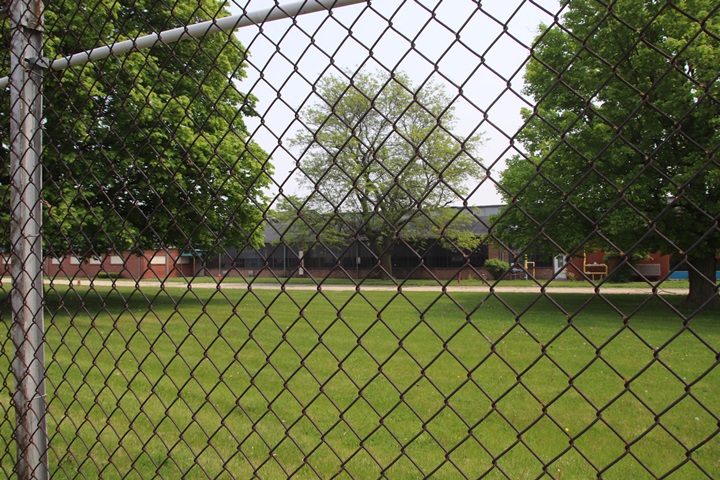
Author's photo.

This factory also stands vacant now that
General Electric has left DeKalb. Author's photo.

Author's photo.

This is the north end of the building with
Pleasant Street in the foreground. Author's photo.
The complete manual for the Mark 1 Winged
Targets is located at:
Winged Targets |

































































